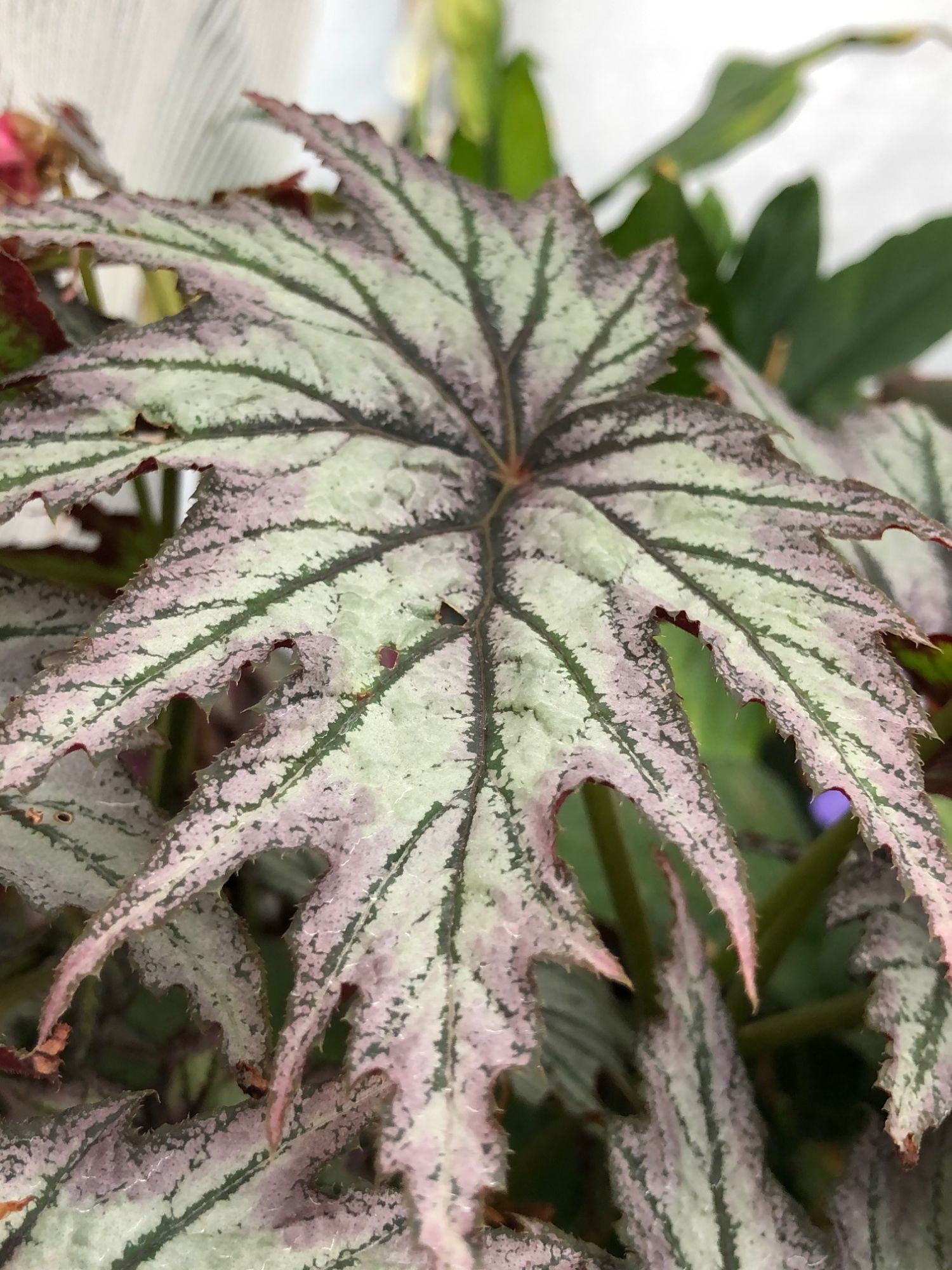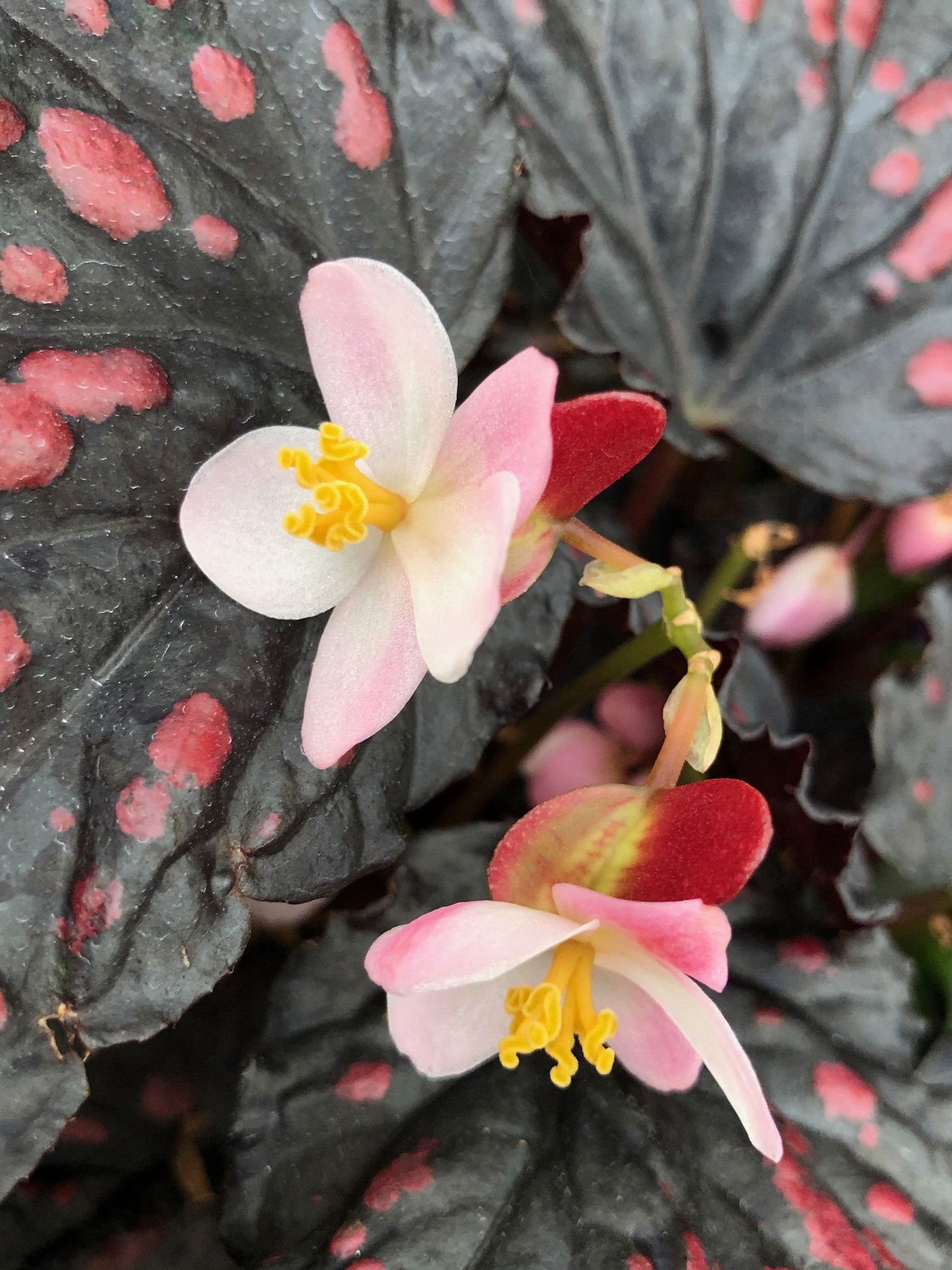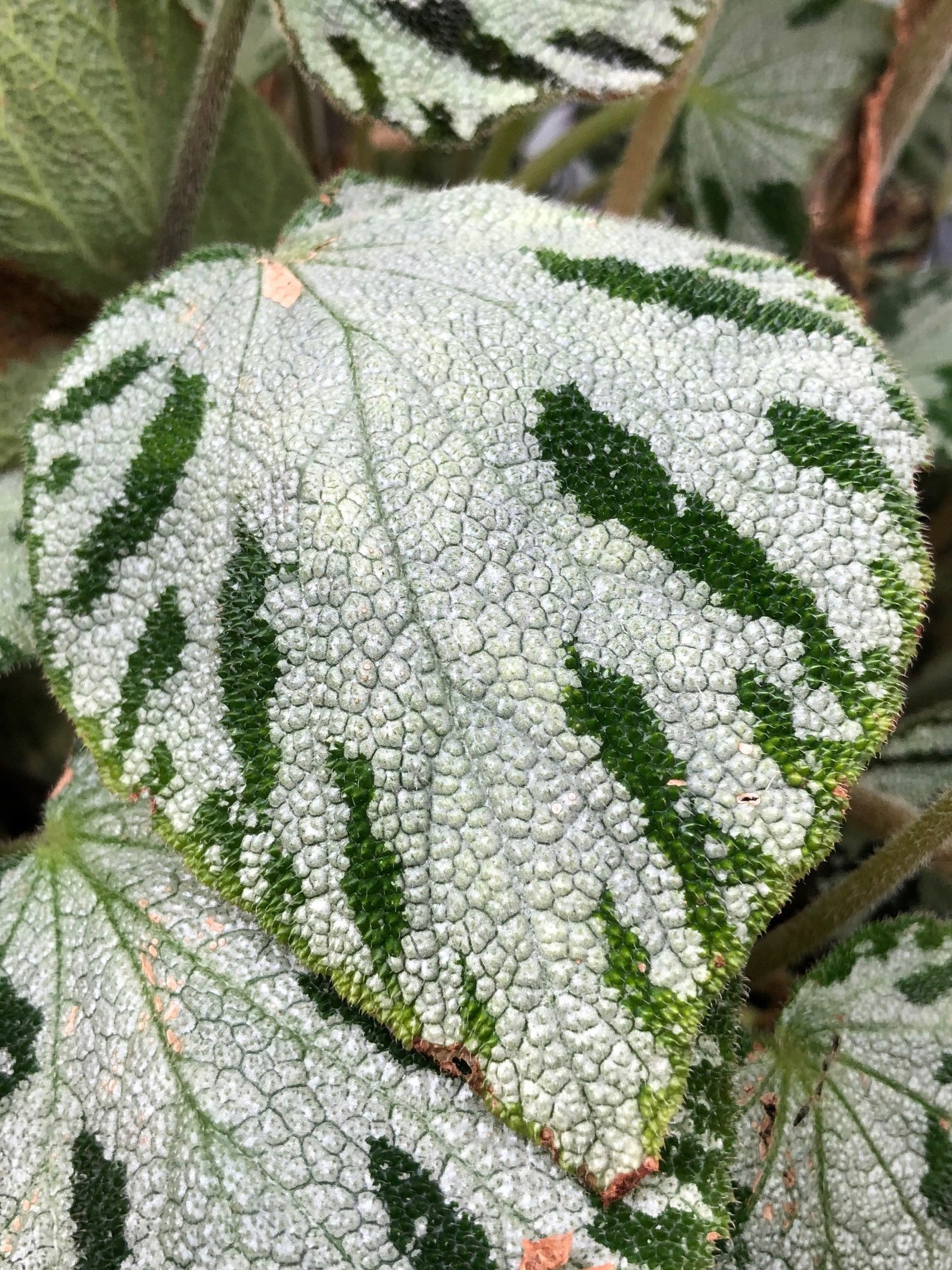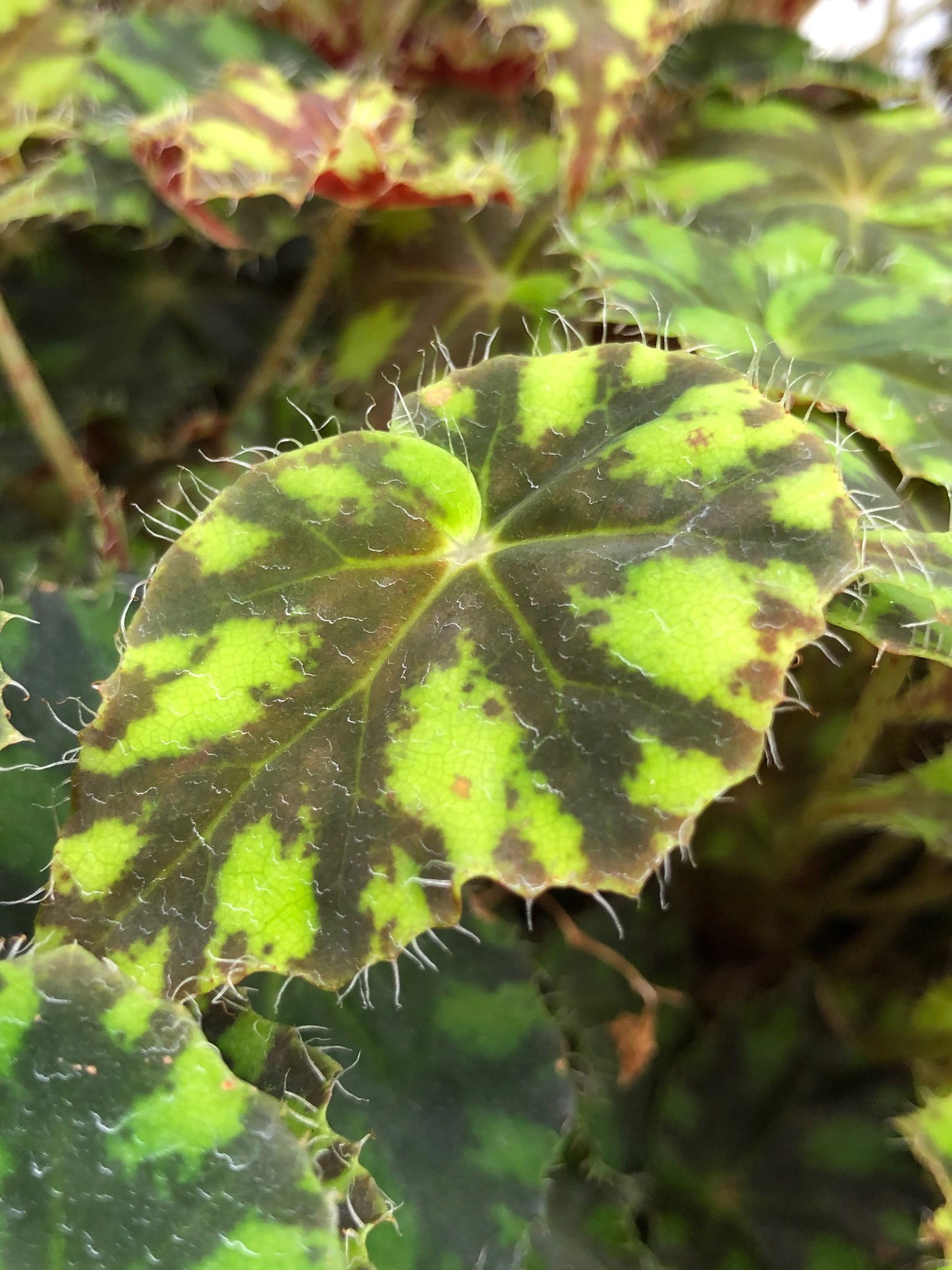
Begonia 'Connie Boswell'
Contents
- Introduction
- Top Tips
- Location, Water, Humidity & Fertilisation
- Common Issues
- Origins, Temperature, Propagation, Repotting & Toxicity
Need the answer to a specific plant query? Book a 1-to-1 video call with THE HOUSEPLANT DOCTOR™, the website's friendly author, to overcome and address your niggling problem! Available on iMessage, WhatsApp, Facebook Messenger & more.
Introduction
Painting Begonia with the same brush is believing that all planets are identical; to this day, there are over 1'800 species of Begonia and 12'000 cultivars. Although they all have dissimilar traits, their overall characteristics are mostly identical. This article is all about how to care for the four main types of Begonia (fibrous, rhizomatous, cane-stemmed & semi-tuberous), all categorised by the lower portion of the plant.
N. B. - Please note that the latter variety is near-impossible to grow indoors, as domestic growing conditions are far from suitable.
- Fibrous rooted Begonia are tender perennial evergreens with shrub-like stems - this group includes B. metallica. Most varieties are grown for their flowers as well as for their foliage, which may be of bold shapes or striking marks, often in silver.
- Rhizomatous Begonia: Those in this group, such as B. rexii are tender, evergreen perennials that grow from a creeping rootstock. Their foliage is often brightly coloured.
- Cane-stemmed Begonia are fibrous-rooted, evergreen tender perennials. Their stems are bamboo-like, with enlarged nodes. They are grown for their large and long-lasting pendulous flowers, along with the beautiful foliage. The best example of this is the B. maculata - see image below.
- Semi-tuberous Begonia are represented by cultivars of B. × hiemalis. These hybrids are not intended for long-term cultivation and are often thrown away once the flowers have been spent. This group isn't recommended for domestic settings.
Top Tips & Info
- Care Difficulty - Moderate
- Allow the top third of the soil to dry out in between waters, reducing this slightly in the autumn and winter months.
- Provide a humid, reliable location by introducing a pebble tray. A constant level of humidity & temperature (12°C, 54°F +) is mandatory to prevent sudden leaf-loss.
- Bright, indirect light is key to quality growth; avoid excessively dark locations as it'll significantly increase the risk of soil-mould & root rot.
- Fertilise using a 'Houseplant' labelled feed every four waters in the spring and summer, reducing this to every six in the colder months.
- Repot every two years with a 'Houseplant' labelled potting mix; be sure to respect the roots as transplant shock is a big issue that could cause wilting, sudden leaf loss or even death.
- Keep an eye out for Spider Mites & Mealybugs that'll inhabit the plant's cubbyholes and foliage.
- If possible, reduce the ambient temperature to around 12°C (54°F) over the autumn and winter to provide a good dormancy. Introduce around two hours of off-peak sunshine thorough this period to avert the heightened chance of root rot and over-watering. Periods of rest will allow better growth in the spring and summer, along with a larger chance of producing blooms.
- Why not buy our top-selling Begonia Soil Mix here? We have sold over 800 batches in the last year alone, so click here to find out more...
Location & Light - 🔸🔸
Domestic Begonia require a bright, indirect setting away from the intense sunlight. Although their outdoor counterparts can survive in prolonged exposure, the indoor variety have softer tissue that's susceptible to sun-scorch and cellular denature. During the autumn and winter, be sure to provide a cool environment with temperatures around 12°C (54°F) and a splash of the morning sun. As the rays will be at their weakest during this time, the warmth and nutritional value will maintain your specimen's wellbeing along with reducing the risk of over-watering. Excessively dark locations should be avoided at all costs due to the heightened chance of soil mould and root rot; if a newspaper can't be read while having your back towards the window, increase the indirect light until satisfactory.
Water - 🔸🔸
Allow the top third of the soil to dry out in between waters, reducing this further in the autumn and winter. Specimens situated in darker areas must be watered far less than those grown in brighter spots to combat the heightened chance of mouldy soil and over-watering.
When irrigating, use tepid water to prevent hurting their sensitive roots from the sudden temperature change - if it's too cold for your teeth, it'll be the same with the plant, too! Although rainwater is best, if you decide to use tap water, allow it to stand for 24hrs to eliminate both chloride and fluoride. Large quantities of these chemicals will gradually build up in the soil over the oncoming months, damaging both its overall health and the soil quality. The final tip to mention is to avoid saturating the fleshy or hairy sections of the plant, as the intricate grooves can hold excess moisture that'll result in bacterial rot. This issue is typically sped up by dark locations that don't offer enough light to dry these sections out naturally. Three ways to counteract this problem is by irrigating with cautiousness, improving the overall light levels and to perform the 'bottom-up method of submersion whenever possible.
Under-watering symptoms include dry leaf-edges, yellowed foliage and slowed growth, which is commonly caused by too much heat or light and forgetfulness. Over-watering symptoms include yellowing lower leaves, stunted growth, heavy soil and collapse. If you feel that root rot has taken over, be sure to evaluate the soil health and click on this link for more information.
Humidity - 🔸🔸
A mixture of humidity and good air circulation is vital for a happy Begonia, and more so with tuberous varieties. Introduce a pebble try to keep the atmospheric saturation high, without the need for misting its foliage. Excess moisture that settles on its leaves may cause the development of rot or botrytis, so it's essential to keep the plant's cubbyholes dry throughout the year.
Fertilisation - 🔸🔸
Fertilise every four waters during the growing period before reducing this to every six in the autumn & winter. Although an 'All-Purpose' fertiliser will still do the job, we'd recommend using a specific 'Houseplant' labelled fertiliser as it'll support the vital thirteen nutrients that this species will need to grow.
While the specimen is budding or in bloom, switch to a product high in potassium to prolong the duration of flowers. Good examples of this are a 'Poinsettia' or 'Tomato' labelled feed. Revert to your original chosen fertiliser once the final bloom elapses.
 The typical inflorescence of Begonia
The typical inflorescence of Begonia
Common Issues with Indoor Begonia
Older leaves that rapidly become yellow are a clear sign of over-watering, usually caused by too little light, with other symptoms include mouldy or heavy soil, stunted growth and a rotten base. Although Begonia can do well in semi-shaded locations, the frequency of irrigations must be reduced to counteract the chance of root rot. People don't realise that a plant's root system needs access to oxygen too; when soil is watered, the air will travel upwards and out of the potting mix. A lack of accessible oxygen will cause them to subsequently breakdown over the oncoming days. Click on this link to learn more about root rot and how to address it.
Small flies hovering around your plant is entirely natural and may just indicate you're watering a little too often. Fungus Gnats are a common 'pest' with Begonia due to its dependency to reliable soil moisture, but won't pose any risk to the plant's health. Simply replace the top quarter of the plant's potting mix for a fresh batch of 'Houseplant' labelled compost, typical found at most garden centres.
Persistent droughts will result in crispy brown sections across its foliage. Allow the affected leaf to thoroughly brown over before removing it with a clean pair of scissors, as puncturing the soft tissue may cause bacterial diseases further down the line. Introduce a watering schedule or pebble tray to avoid the risk of dehydration in the future.
Dry air may cause browning leaf tips with yellow halos. Although this won't kill the plant, increase humidity to prevent new growth in adopting these symptoms. Either mist weekly while the heaters are on, or create a humidity tray to present a better growing condition.
Clean the leaves regularly. Although this isn't too much of an issue, a build-up of dust particles can clog up the plant's pores, causing lowered light capturing-efficiency. Rinse the topsides of the leaves down once a month to keep levels down and improve growing conditions, ensuring its foliage is dry again within the hour.
 Powdery Mildew looks like a white slightly moist layer that covers your Begonia's leaf. Although this may look harmless, it could weaken the plant enough to kill it, if untreated. We recommend wiping the foliage with a damp soapy cloth and use a fungicide from a local garden centre or online store. Improve the plant's environmental needs by increasing the light levels and reduce watering, too. This Mildew best grows in cold, damp areas with overly moist soils.
Powdery Mildew looks like a white slightly moist layer that covers your Begonia's leaf. Although this may look harmless, it could weaken the plant enough to kill it, if untreated. We recommend wiping the foliage with a damp soapy cloth and use a fungicide from a local garden centre or online store. Improve the plant's environmental needs by increasing the light levels and reduce watering, too. This Mildew best grows in cold, damp areas with overly moist soils.
The browning of the sheath's casing shouldn't of be a concern, as it's a wholly natural process which affects all specimens across the world. Remove the brown section once it becomes dry and crispy, using your hands to peel back the browned tissue and improve its overall appearance.
A lack of flowers is caused by an insufficient dormancy period, where the temperatures are kept more or less the same over the year. Reduce the warmth by a couple of degrees over the autumn and winter months, along with fewer irrigations to ensure a well-spent dormancy. Supplement in the weeks leading up to potential buds (early summer) with a potassium-based fertiliser, for instance, tomato food.
 Begonia 'Silver Jewel'
Begonia 'Silver Jewel'
Origins
The name, Begonia, was penned by Charles Plumier who was a French botanist in the seventeenth century. Carl Linnaeus adopted this name in 1753, honouring a well-respected governor of Haiti, named Michel Bégon. The genus has almost two thousand accepted species that have natural distributions across five continents, except Europe and Antarctica.
 The Distribution of Begonia
The Distribution of Begonia
Temperature
12° - 21°C (55° - 70°F)
Although most outdoor Begonia can withstand much lower temperatures than stated above, those sold for domestic use are best situated between 12° - 21°C , as many varieties are classified as 'H1b' (best-grown under glass all year round or outside in a sheltered spot above 12°C), according to the RHS.
Spread
Sizes vary from 10 - 120cm in height, and 10 - 50cm in width. Most indoor varieties sold today are usually in the region of 20cm in length, but will gradually grow taller and broader as the months and years progress.
Smallest varieties on the market: Black Knight, Marmaduke, Listada, Sea Urchin, Red Robin & Silver Lace.
Biggest varieties on the market are Albo picta 'Rosea', B. luxurians & B. wollnyi.
Pruning
Remove yellow or dying leaves, and plant debris to encourage better-growing conditions. While pruning, always use clean utensils or shears to reduce the chance of bacterial and fungal diseases. Never cut through yellowed tissue as this may cause further damage in the likes of diseases or bacterial infections. Remember to make clean incisions as too-damaged wounds may shock the plant, causing weakened growth and a decline in health.
 Begonia 'Nematode'
Begonia 'Nematode'
Propagation
Via Seed, Offset Division or Rhizomatous Division (tuberous Begonias only). With Fibrous and Rhizomatous varieties, young growth can be taken as stem cuttings in spring. See this link for more info - RHS Begonia Care.
Repotting
Repot every two years in the spring, using a 'Houseplant' labelled compost and the next sized pot with adequate drainage. Hydrate the plant 24hrs before tinkering with the roots to prevent the risk of transplant shock. For those that are situated in a darker location, add a thin layer of small grit in the pot's base to improve drainage and downplay over-watering. Click here for a detailed step-by-step guide on transplantation, or via this link to learn about repotting with root rot.
Book a 1-to-1 video call with THE HOUSEPLANT DOCTOR™ if you'd like a personal guide to repotting your houseplant. This will include recommending the right branded-compost and pot size, followed by a live video call whilst you transplant the specimen for step-by-step guidance and answer any further questions!
Pest & Diseases
Keep an eye out for mealybugs, aphids, spider mites, scale, thrips, blackfly & vine weevils that'll locate themselves in the cubbyholes and undersides of the leaves, with the exception of the latter in soil. Common diseases associated with Begonia are root rot, anthracnose, cercospora, leaf-spot disease, botrytis (grey mould), rust, powdery mildew & southern blight - click here to learn more about these issues.
Toxicity
This plant is classified as poisonous, so if small sections are eaten, vomiting, nausea and a loss of appetite may occur. Consumption of large quantities must be dealt with quickly; acquire medical assistance for further information.
Retail Locations
Blue Diamond, British Garden Centres, Dibley's, Dobbies, Online Stores.
Book a 1-to-1 Call with THE HOUSEPLANT DOCTOR™
If you need further advice with your houseplants, book an advice call with ukhouseplants' friendly and expert writer today! This can be done via a video or audio call on most apps, including Facebook, FaceTime & Skype. A ten-minute call costs £5.99 (US$7), or £15.99 for thirty minutes. You can ask multiple questions, including queries on plants, pests, terrariums, repotting advice and anything in between. Please consider supporting this service to keep ukhouseplants thriving!